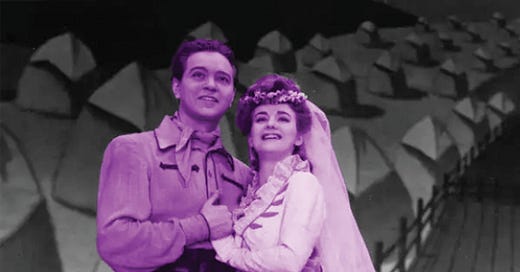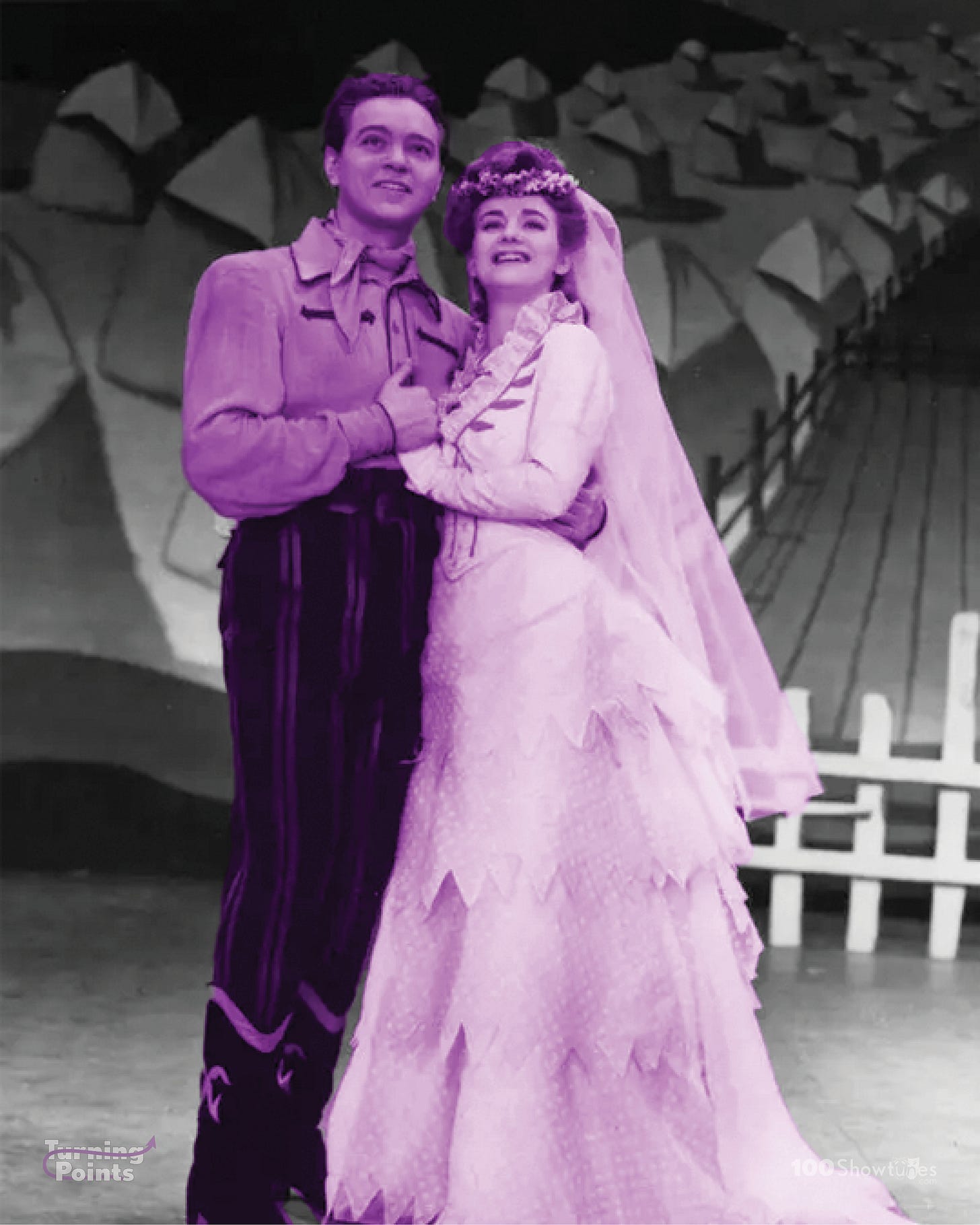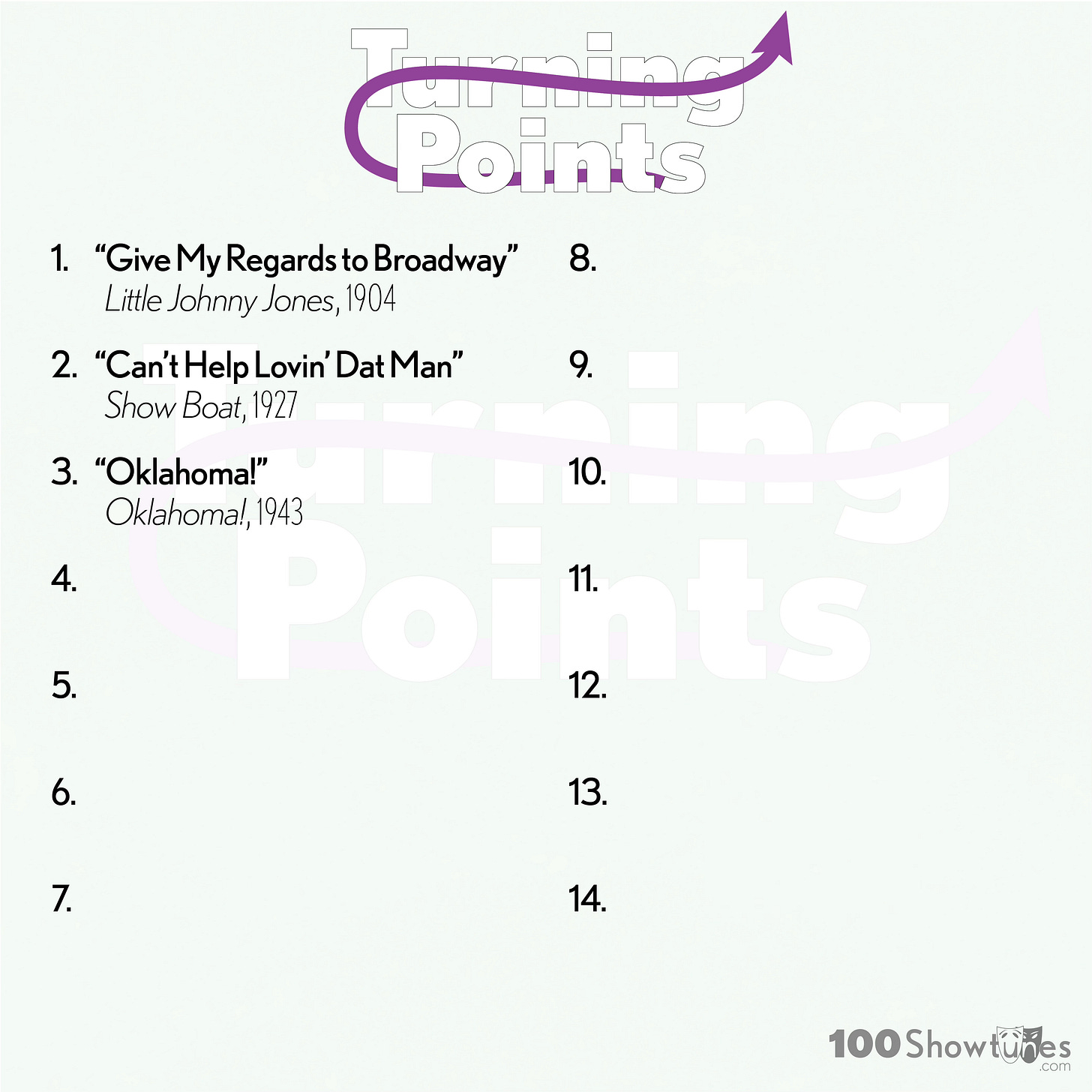No. 3 “Oklahoma!”
OKLAHOMA! (1943). Music by Richard Rodgers, Lyrics and Book by Oscar Hammerstein II. Based on the play GREEN GROW THE LILACS by Lynn Riggs
It’s 1943, and you’re seeing Oklahoma!. After a cracking overture, you expect a splashy chorus of beautiful girls, but are instead greeted by a woman churning butter as a lone voice can be heard singing, offstage and a capella, about the beautiful morning. It’s the Oklahoma territories at the turn of the 19th to 20th centuries. The butter churner is Aunt Eller, who runs a farm, and the singer is Curly, a charming cowboy. Curly and Laurie (Eller’s niece) ::wink wink:: can’t stand each other ::wink wink::. Jud, Eller’s vaguely menacing farmhand, more openly courts Laurie. Act I ends with an extended and innovative dream ballet that dramatizes Laurie’s conflict: go for the guy she’s too proud to admit she loves or the one she’s afraid to reject. By the end of Act II, Laurie marries Curly, and the Oklahoma territories become a state, which the wedding party celebrates with the rousing “Oklahoma!”. Then Jud shows up, imposes himself on Laurie, tries to stab Curly, falls on his own knife, and dies. The wedding guests hold an impromptu trial that declares Curly acted in self-defense before reprising the title song as the curtain falls.
After his success with Show Boat Oscar Hammerstein spent the 1930s continuing to write operettas. Richard Rodgers spent the 1930s writing popular, urbane musical comedies with Lorenz Hart. They came together in 1943, as two sides of the musical theater coin. It proved to be an ideal partnership. Hammerstein’s dramaturgical integrity pushed Rodgers to compose more sweeping and varied music tied to specific characters and situations. Rodgers’ more colloquial music allowed Hammerstein to write more naturalistic material for homespun characters. And they reinvented the musical in the process. In Oklahoma! Rodgers and Hammerstein adapted a modestly successful play by using singing and dancing to support and enhance the story and its themes. The songs in Oklahoma! further the plot, and enrich one’s understanding of the characters singing them, creating a fully integrated musical play. And unlike Show Boat, which was recognized as innovative but ended up being a bit of a one-off, Oklahoma!set a new model of musical theater writing that quickly became standard practice.
Recommended Recording:”Oklahoma!,” Oklahoma! (1943 Original Broadway Cast)
Oklahoma! spawned the first true Original Cast Recording—one that featured the original cast, orchestra, arrangements, and conductor. As would be customary for cast recordings until digital music, they could only capture about 40ish minutes of music. This particular song is trimmed of its opening verse, which is just was well because it’s more fun to dive right in to the chorus anyway. Alfred Drake’s clear baritone and the ensemble’s vocal arrangement is thrilling.
Alternate Performances
Oklahoma! has spawned ~40 cast recordings, plus instrumental and pop recordings, a movie, two pro shots, and a BBC Proms cocnert. The title song has also made memorable appearances on 3rd Rock from the Sun and the Watchmen miniseries.
1955 Film: Directed by Fred Zinnemann, the first film adaptation of a Rodgers and Hammerstein musical is dutifllly faithful with minimal cuts to the score (a rarity for stage-to-screen transfers at the time). The score, arranged by original orchestrator Robert Russell Bennett, comes off well, and it’s nice to see Agnes DeMille adapt her original choreography. The reverent approach to the material renders the movie a bit stiff and chaste, and is probably a big reason everyone is surprised the show is sexy and violent when it gets revived. But the performances are great, with Gordon MacRae as a fine Curly and Shirley Jones making her screen debut as Laurie.
1998 London Revival: Director Trevor Nunn and choreographer Susan Stroman took a fresh look approach in this revival. It was the first major production to set aside DeMille’s choreography and the have the leads dance in the dream ballet (traditionally, ballet dancers represented the leads). A pre-Wolverine Hugh Jackman played Curly, which naturally brought the sexual subtext to the foreground. A pro-shot aired on PBS and remains commercially available. Patrick Wilson led a 2002 Broadway transfer.
2019 Broadway Revival: Daniel Fish directed the most radical commercial revival of Oklahoma! to date, keeping every word of Hammerstein’s libretto, but framing it in terms of toxic masculinity and entitlement. Jud’s death is much more ambiguous, with Curly shooting Jud leaving Laurie and Curly to sing the finale covered in blood splatter.
Is it Covered by The Rat Pack, Audra McDonald, or Glee?
The Rat Pack: Frank Sinatra recorded two Oklahoma! songs in 1943 (“People Will Say We’re in Love” and “Oh What a Beautiful Morning”), but not the title song.
Audra McDonald has not recorded “Oklahoma!,” but she’s appeared in concerts where the song appeared, like 2023’s My Favorite Things: The Rodgers & Hammerstein 80th Anniversary Concert. She’s also basically an international ambassador for Rodgers & Hammerstein.
Glee: A young Sue Silvester was supposed to sing “Oklahoma!” in season three episode six of Glee (“Mash Off”), but the number was cut.
In the Wings
While you wait for song No. 4 to drop, you may want to look up the phrase “No legs, no jokes, no chance,” a classic bit of Broadway lore.







My daughter Anna first saw the movie when she was three. For the next few years she referred to it as The Big Homa when she asked us to play the DVD.
When I was teaching at Hawken we had an exchange program with a Japanese school. When they visited, we took the students to see a community production of OKLAHOMA! Because of the language issue and the age of the actors, some of the students thought that Jud was Laurie's father, which added an interesting element to the musical.